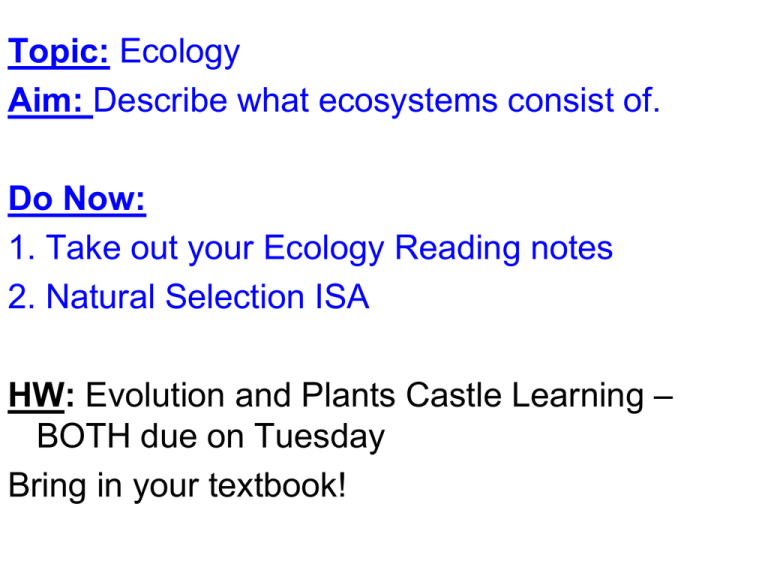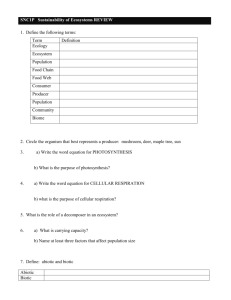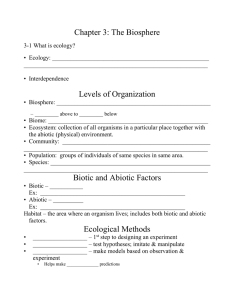Introduction to Ecology
advertisement

Topic: Ecology Aim: Describe what ecosystems consist of. Do Now: 1. Take out your Ecology Reading notes 2. Natural Selection ISA HW: Evolution and Plants Castle Learning – BOTH due on Tuesday Bring in your textbook! 1. Identify the common ancestor. Ground finch 2. Identify the part of Natural Selection represented in the diagram. Support your answer. Speciation. One species evolved into many species. 3. Does this diagram represent gradualism or punctuated equilibrium? Support your answer. Gradualism – slow change over time. Why is there a branching pattern in the circled region labeled X? 1. Changes in the environment caused some species to become extinct. 2. Different species evolved because of inbreeding 3. There were no new species evolving at this time. 4. Changes in the environment caused some different species to develop. 1. Identify the process occurring in this test tube. photosynthesis 2. What do the bubbles of gas represent? oxygen 3. What gas is being used by the elodea? carbon dioxide 4. Identify the source of energy for this process. sunlight 5. In which part of the plant will photosynthesis occur? leaves 6. Why are all organisms dependent on plants? They produce the glucose needed for respiration. a. Ecology • Branch of biology that deals with the interactions between organisms and their surrounding environment b. Ecosystem • Consists of all BIOTIC and ABIOTIC factors in the environment c. Abiotic Factors • NONLIVING factors in the environment d. Biotic Factors • All LIVING organisms in the environment 2. Identify two examples of ABIOTIC factors. • Temperature, different chemicals, rocks, fallen logs, H2O, sand 3. Identify two examples of BIOTIC factor. • Plants or animals living in ecosystem 4. Identify the term that describes many organisms from ONE SPECIES living in the same area. • Population 5. Identify the term that describes DOFFERENT SPECIES living in the same area. • Community 6. Identify the organisms that can produce their own food. • Producers • Autotrophs • Photosynthesis A B C 7. Identify the term that must eat because they cannot make their own food. • Consumers • Heterotrophs 8. Identify consumers that only eat producers. • Herbivores 9. Identify consumers that only eat other animals. • Carnivores 10. Identify carnivores that hunt for their prey. • Predators 11. Identify carnivores that eat dead organisms they find. • Scavengers 12. Identify consumers that eat both producers and consumers. • Omnivores 13. Identify consumers that break down dead organisms and return some of those nutrients back to the soil. • Decomposers 14. Identify two examples of decomposers. • Bacteria • Fungi 15. Describe a habitat. • The place where an organism lives 16. Describe a niche. • The role of a species in its environment Paramecium caudatum Species grown together Paramecium aurelia 16. Describe a niche. • The role of a species in its environment • Competition when 2 species share the same niche 17. Identify two examples of niches. • • • • How a species obtains food How it finds a mate How it cares for its young How it avoids danger Cowrie snails live in coral reefs and sponges to hide. They only go out to find food at night, when it's dark. They are often eaten by each other and other sea snails. As Live Aquari a states, "While small, it will eat some algae and scavenge for scraps, but as an adult, it will eat some anemones, sponges, and soft corals." In the diagram, many bird species live on the same tree. 1. Are they sharing the same habitat? YES 2. Are they sharing the same niche. Support your answer. No. They are coexisting so there is no competition. Let’s summarize by identifying what is being described. 1. One species living in the same area. Population 2. The role an organism plays in its habitat. Niche 3. Only eat producers. Herbivores 4. Break down dead organisms. Decomposers 5. Hunt for their food. Predators Omnivores 6. Organisms that consume both plants and animals. 7. Consists of biotic and abiotic factors. Ecosystem 8. Where an organism lives. Habitat 9. Produce their own food. Producers 10. Many species living in the same area. Community 11. Feed off of organisms that have already been killed. Scavengers 1. Identify some biotic factors in the diagram. Deer, trees, frog, duck, plants 2. Identify some biotic factors in the diagram. Water, oxygen, soil 3. Identify what this diagram represents? Support your answer. An ecosystem because it contains biotic and abiotic factors. In a natural community, all the living things that directly or indirectly affect the environment are known as (1.) pioneer organisms (2.) secondary consumers (3.) climatic limitations (4.) biotic factors Which group can best be described as a population? (1.) all the honeybees in an orchard (2.) all the plants and animals in a forest (3.) the life in Earth's atmosphere (4.) the living and nonliving factors in a meadow A certain plant requires moisture, O2, CO2, light, and minerals in order to survive. This statement shows that a living organism depends on (1.) abiotic factors (2.) biotic factors (3.) carnivore-herbivore relationships (4.) symbiotic relationships 1. The substance in green plants that captures Chlorophyll the sun’s energy is _____. 2. The process in which light energy is converted photosynthesis into chemical energy is known as ____. 3. A process in which glucose is broken down to Cellular respiration release energy is called ___. 4. The plant structure that absorbs water and roots minerals from the soil are _____. 5. The tissue found in stems and leaves that transport materials throughout the plant is called vascular tissue. _______ 1. CO2 and The raw materials of photosynthesis are _____. and H2O 2. The vascular tissue that transports water up from the xylem roots to the leaves is _____. autotrophs 3. Plants that use photosynthesis are ______. 4. The source of energy for photosynthesis is _____. sunlight 5. The vascular tissue that transport food throughout the phloem plant is called _______. 6. The “chemical energy” produced during glucose photosynthesis is _______. oxygen 7. The waste gas released by plants is ____. 8. In a plant, photosynthesis occurs in _____. leaves 9. The wavelengths of light that are most effective for red and blue photosynthesis are _________________. 1. Which letter represents a common ancestor for species C and E? K 2. Which species are least likely to be vital parts of a present-day ecosystem? E and J 3. Identify the species that have not become extinct. A, B, C and D 4. Does this diagram represent gradualism or punctuated equilibrium? Gradualism 5. Identify a possible reason why species J became extinct. •It lacked variation and their was a large environmental change that it could not adapt to.







